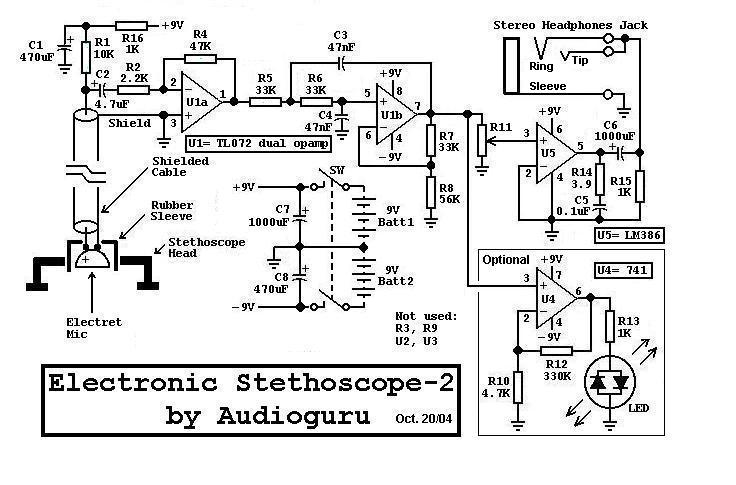 U1a operates as a low-noise microphone preamp. Its gain is only about 3.9 because the high output impedance of the drain of the FET inside the electret microphone causes U1a’s effective input resistor to be about 12.2K. C2 has a fairly high value in order to pass very low frequency (about 20 to 30Hz) heartbeat sounds.
U1b operates as a low-noise Sallen and Key, Butterworth low-pass-filter with a cutoff frequency of about 103Hz. R7 and R8 provide a gain of about 1.6 and allow the use of equal values for C3 and C4 but still producing a sharp Butterworth response. The rolloff rate is 12dB/octave. C3 and C4 can be reduced to 4.7nF to increase the cutoff frequency to 1KHz to hear respiratory or mechanical (automobile engine) sounds.
The U4 circuit is optional and has a gain of 71 to drive the bi-colour LED.
U5 is a 1/4W power amplifier IC with built-in biasing and inputs that are referred to ground. It has a gain of 20. It can drive any type of headphones including low impedance (8 ohms) ones.
 Parts
R1 10K 1/4W Resistor
R2 2.2K 1/4W Resistor
R3, R9 Not used
R4 47K 1/4W Resistor
R5, R6, R7 33K 1/4W Resistor
R8 56K 1/4W Resistor
R10 4.7K 1/4W Resistor
R11 2.2K to 10K audio-taper (logarithmic) volume control
R12 330K 1/4W Resistor
R13, R15, R16 1K 1/4W Resistor
R14 3.9 Ohm 1/4W Resistor
C1, C8 470uF/16V Electrolytic Capacitor
C2 4.7uF/16V Electrolytic Capacitor
C3, C4 0.047uF/50V Metalized plastic-film Capacitor
C5 0.1uF/50V Ceramic disc Capacitor
C6, C7 1000uF/16V Electrolytic Capacitor
U1 TL072 Low-noise, dual opamp
U2, U3 Not used
U4 741 opamp
U5 LM386 1/4W power amp
MIC Two-wire Electret Microphone
J1 1/8" Stereo Headphones Jack
LED Red/green 2-wire LED
Batt1, Batt2 9V Alkaline Battery
SW 2-pole, single throw Power Switch
Misc. Stethoscope head or jar lid, Rubber Sleeve for microphone. Assembly:
1) Assemble the circuit using Veroboard (stripboard) or a PCB.
2) Use a shielded cable for the microphone as shown on the schematic.
3) Fasten the microphone to the stethoscope head with a rubber isolating sleeve or use a short piece of rubber tubing on its nipple. A thick jar lid can be used as a stethoscope head. The microphone must be spaced away from the skin but the stethoscope head must be pressed to the skin, sealing the microphone from background noises and avoiding acoustical feedback with your headphones.
4) The microphone/stethoscope head must not be moved while listening to heartbeats to avoid friction noises.
5) Protect your hearing. Keep the microphone away from your headphones to avoid acoustical feedback.
|





